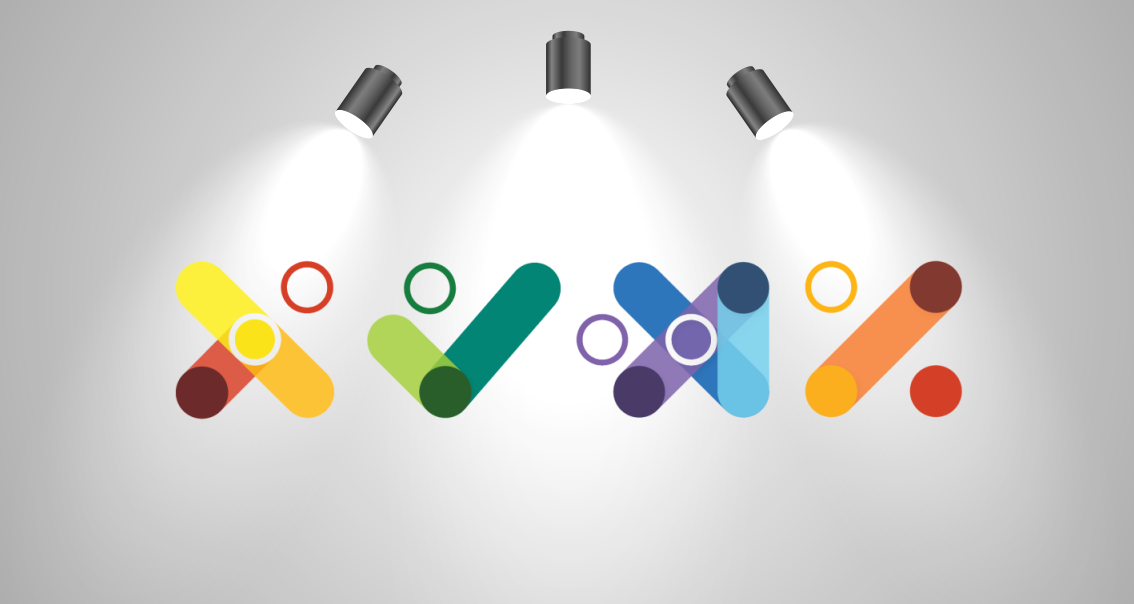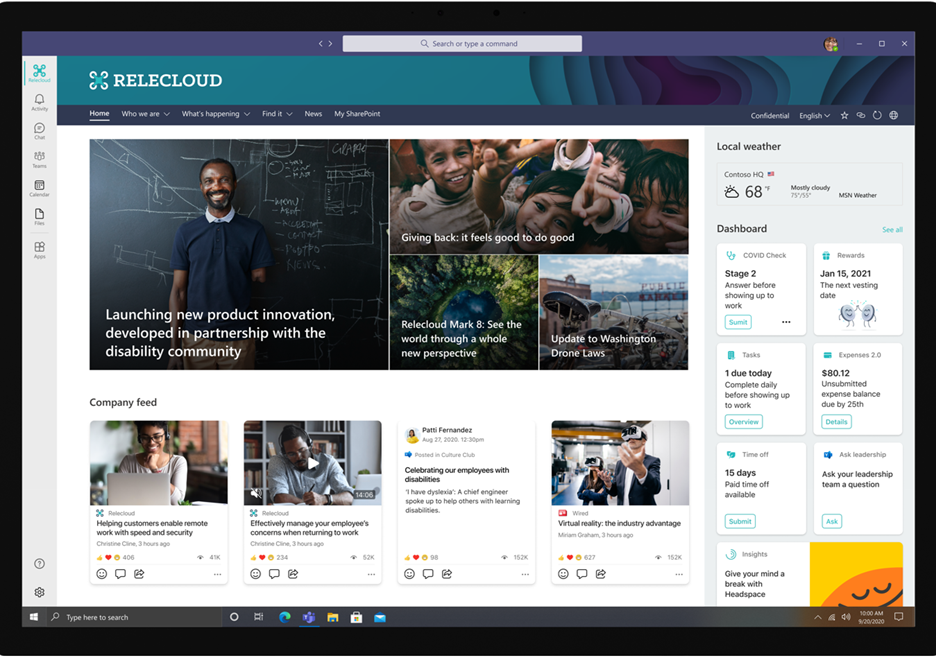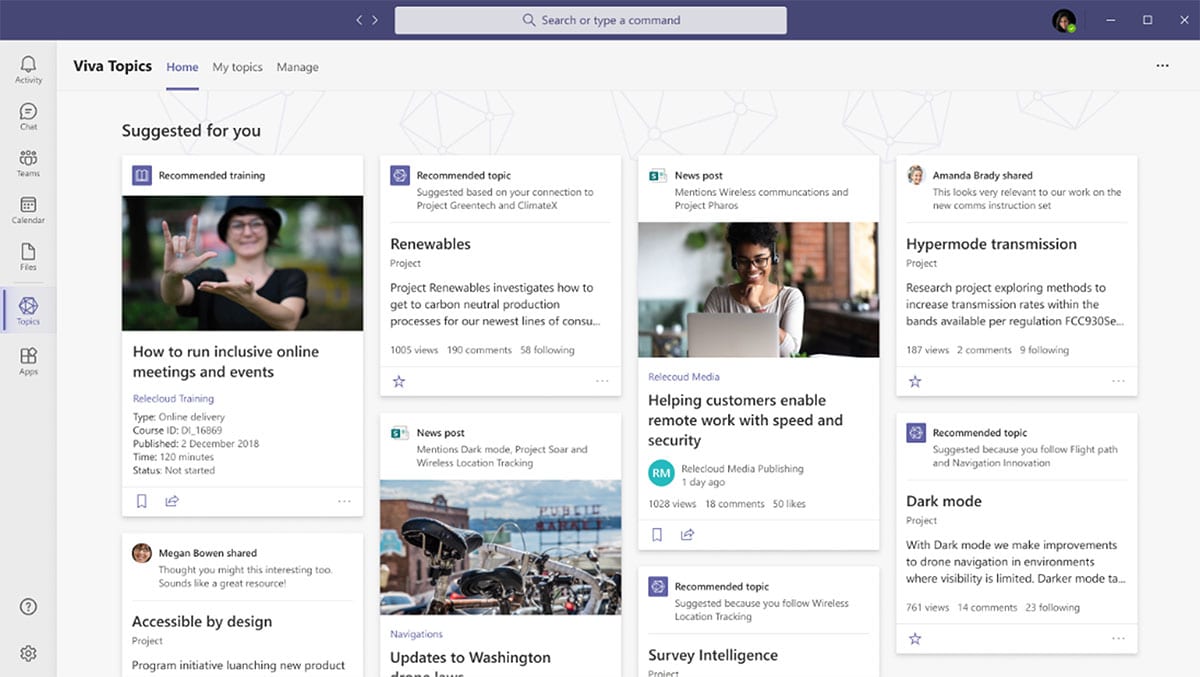
A few years ago I was working on a digital workplace strategy. We met with several companies looking at mobile solutions, intranets, platforms and so on. One company had rolled out mobile devices and had set up their own app store. They had over 200 apps in the store for their people to use. They even had an app to tell you which app to use. They were proud. I was horrified.
It was symptomatic of a service led approach to digital tools. Each service area buys a system that supports their back office process. Vendors stick a web front-end on and convince the C-suite that this will make it easy to use. They then spend a huge amount on change management to push it on employees who are already swamped with tools and information. Even Microsoft 365 was a mix of different products with multiple interfaces and competing functions…until now.
Microsoft Viva has arrived
Back in 2014 Deliotte had already started highlighting the need to work on the digital employee experience. With the announcement of Microsoft Viva, Microsoft are finally making the leap into an employee first experience and may well drag a large part of the technology sector with them (see Josh Breslin’s excellent view on the market impact of Viva).
Microsoft are pitching Viva as a digital employee experience platform. The initial offering aims to improve four experiences common across many enterprises and organisations.
I’ve often defined digital employee experience as the digital tools, systems, content, and experiences that connect people to the delivery of individual, team and organisational goals. With this in mind, it’s easy to see how Viva can provide the systems and tools to help deliver those key experiences.
Viva Connections
Connections is the gateway to modern employee experience; helping people to connect from anywhere. It provides internal communicators with the ability to provide staff with a curated, personalised and company-branded experience. Connections surfaces news content, conversations (from sources like Yammer) and other relevant information right within Microsoft Teams.
Leveraging the power of SharePoint Online, Viva Connections provides a single-entry point for employee engagement and internal communications.

Viva Insights
Viva Insights provides employees with personalised recommendations and insights on how to be more productive by working smarter, not harder. It uses data from Outlook to provide individuals with tips on how to generate healthy and productive work habits such as booking focus time and scheduling regular breaks.
With more people working remotely, Viva Insights provides individuals and managers with recommended actions and tips to reduce the likelihood of burnout and introduces new personal wellbeing experiences, which are all delivered through Microsoft Teams.

Viva Topics
Viva Topics gives time back to employees by showing them the content that matters most, without the need for custom search.
Viva Topics is like Wikipedia with AI superpowers! Allowing organizations to surface relevant and contextual information (such as files, sites and pages) from the Microsoft 365 ecosystem and third-party services, like ServiceNow and Salesforce.

Viva Learning
With Viva, employees will be able to easily discover new training courses to keep updated with new technologies and with the one they are already using.
Viva Learning aggregates content from LinkedIn Learning, Microsoft Learn, your organization’s own custom content, and trainings from leading content providers like Skillsoft, Coursera, Pluralsight, and edX.
Like the other Viva components, Viva Learning integrates seamlessly with Microsoft Teams, providing people with a central hub to discover, share and learn.

Four changes Viva will drive
It’s significant that Microsoft are advocating a focus on the experience of employees. Their investment in tools aligned with modern ways of working has been service driven, but now they have shifted to place the employee at the centre of their offerings rather than seeing them as a simply a ‘user’. This shift should drive significant change.
A digital ‘front door’
Looking from an employee point of view, they need to have a digital experience they can trust, that reflects their needs and enables them to do their job simply and efficiently. By bringing the services within M365 together within a single entry point, Viva can act as that digital front door for the organisation. In particular Viva connections brings news, community updates and tasks together, whilst Viva topics applies AI to curate knowledge and expertise and serve them to people as they need it. As a person regularly involved in change and adoption programs, the move to provide a single starting point for people to do their work should bring a reduction in the ‘which tool when’ confusion and debate.
Additionally, Microsoft have worked hard to partner with other system providers to bring their offerings into the mix. Surfacing and connecting with key HR and learning systems keeps the experience ‘joined-up’ for employees.
Closing the gap between IT and the rest of the organisation
My experience is that often the IT departments of organisation buy and deploy the systems and leave the rest of the organisation to work out how these tools can be used. Traditionally Microsoft have supported this by focusing their marketing and sales on IT departments. Viva changes this.
Employee experience is not owned by one single department. The experiences cut across IT, HR, Internal Communications and other stakeholders. Microsoft can push organisations to build the coalitions around employee experience necessary to deploy and capitalise on these new offerings.
A move to ‘micro’ tasks and reduced context switching
Slightly buried in the launch announcements is the surfacing of personalised tasks and activities as part of Viva Connections. During the course of a work day employees are often faced with small, micro tasks such as reviewing and submitting leave requests, or completing a performance review. Traditionally these would involve switching into the relevant system, but Viva Connections now provides a dashboard to consolidate these tasks at a personal level. Breaking the small tasks away from the backend system that helps manage them means people don’t have to switch context to complete them.
A shift of focus from productivity to people
Perhaps most importantly, Viva will drive sensible and data supported conversations about work and wellbeing through Viva Insights. As remote and hybrid working models seem set to become the new normal, managing potential burn-out and wellbeing issues increases in importance. At an individual level, the setting of breaks and focus time, along with advice from Headspace will help build engaged and resilient employees. Leaders and organisations can also take a more holistic view and identify potential issues before they arise. The insights also support the redesign of work to reduce stress and improve mental health of employees.
The use of MS Teams as the delivery mechanism for Viva means that the experience is available via mobile devices. This places engagement in the hands of many front line workers for the first time. This helps close the digital divide often seen between different roles in an organisation. Connecting with those often deemed hard to reach means organisations can give a voice to those previously excluded.
Four things Viva won’t change
It’s significant that Microsoft are advocating a focus on the experience of employees. Their investment in tools aligned with modern ways of working has been service driven, but now they have shifted to place the employee at the centre of their offerings rather than seeing them as a simply a ‘user’. This shift should drive significant change.
A digital ‘front door’
Looking from an employee point of view, they need to have a digital experience they can trust, that reflects their needs and enables them to do their job simply and efficiently. By bringing the services within M365 together within a single entry point, Viva can act as that digital front door for the organisation. In particular Viva connections brings news, community updates and tasks together, whilst Viva topics applies AI to curate knowledge and expertise and serve them to people as they need it. As a person regularly involved in change and adoption programs, the move to provide a single starting point for people to do their work should bring a reduction in the ‘which tool when’ confusion and debate.
Additionally, Microsoft have worked hard to partner with other system providers to bring their offerings into the mix. Surfacing and connecting with key HR and learning systems keeps the experience ‘joined-up’ for employees.
Closing the gap between IT and the rest of the organisation
My experience is that often the IT departments of organisation buy and deploy the systems and leave the rest of the organisation to work out how these tools can be used. Traditionally Microsoft have supported this by focusing their marketing and sales on IT departments. Viva changes this.
Employee experience is not owned by one single department. The experiences cut across IT, HR, Internal Communications and other stakeholders. Microsoft can push organisations to build the coalitions around employee experience necessary to deploy and capitalise on these new offerings.
A move to ‘micro’ tasks and reduced context switching
Slightly buried in the launch announcements is the surfacing of personalised tasks and activities as part of Viva Connections. During the course of a work day employees are often faced with small, micro tasks such as reviewing and submitting leave requests, or completing a performance review. Traditionally these would involve switching into the relevant system, but Viva Connections now provides a dashboard to consolidate these tasks at a personal level. Breaking the small tasks away from the backend system that helps manage them means people don’t have to switch context to complete them.
A shift of focus from productivity to people
Perhaps most importantly, Viva will drive sensible and data supported conversations about work and wellbeing through Viva Insights. As remote and hybrid working models seem set to become the new normal, managing potential burn-out and wellbeing issues increases in importance. At an individual level, the setting of breaks and focus time, along with advice from Headspace will help build engaged and resilient employees. Leaders and organisations can also take a more holistic view and identify potential issues before they arise. The insights also support the redesign of work to reduce stress and improve mental health of employees.
The use of MS Teams as the delivery mechanism for Viva means that the experience is available via mobile devices. This places engagement in the hands of many front line workers for the first time. This helps close the digital divide often seen between different roles in an organisation. Connecting with those often deemed hard to reach means organisations can give a voice to those previously excluded.